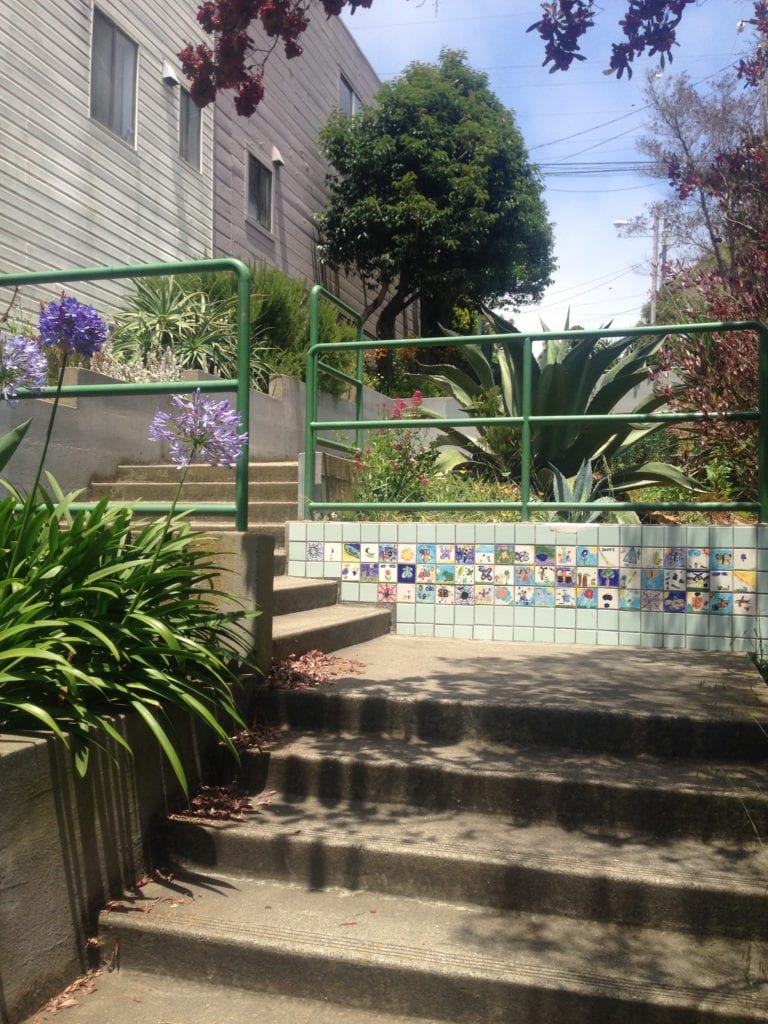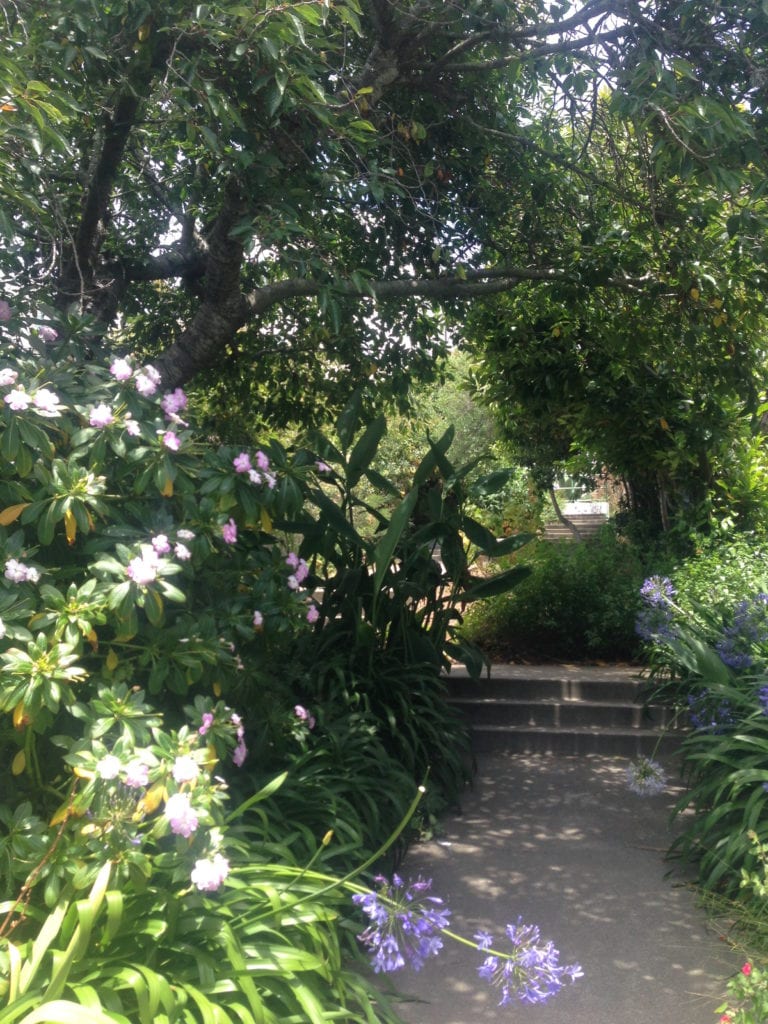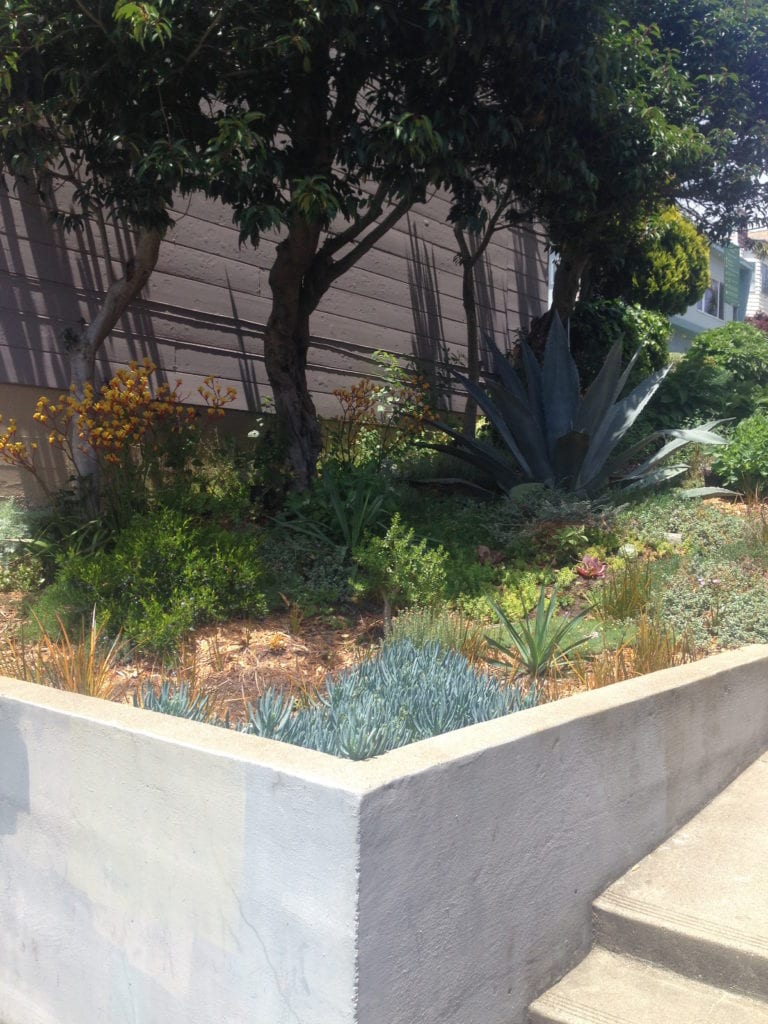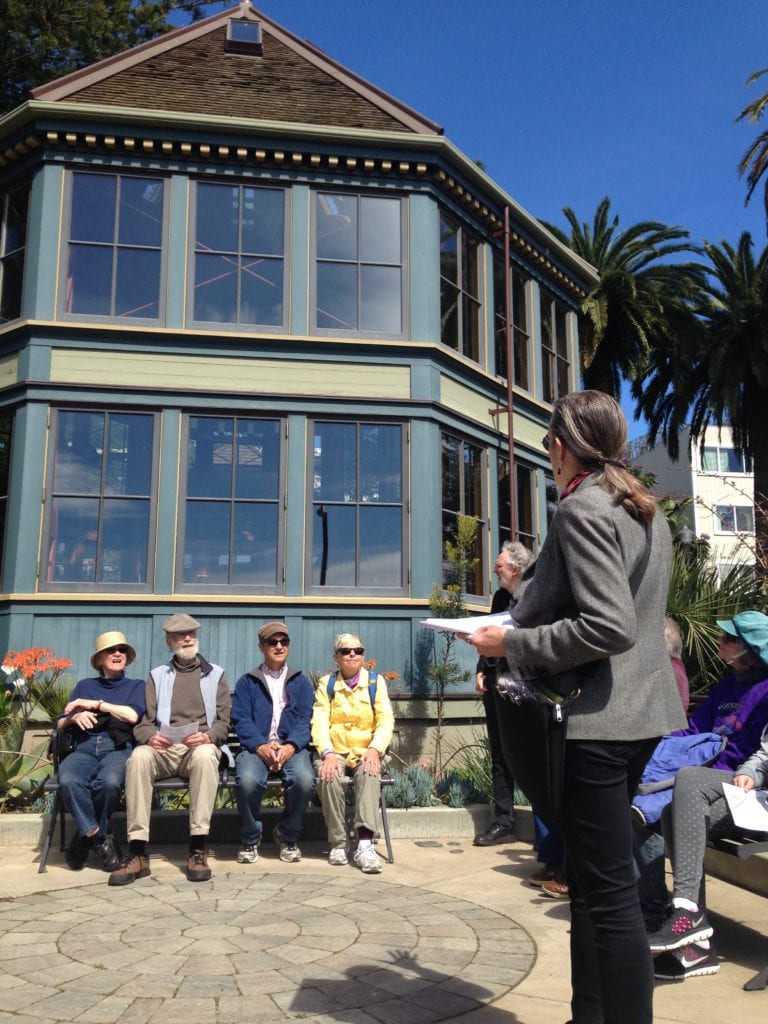
Story and photos by Murray Schneider
If you’re up for a walk, take a moment to amble over to Sunnyside’s Joost & Baden Mini-Park.
Tucked away between Joost Avenue and Mangels Avenue, the whimsical corridor is sandwiched between the Sunnyside Conservatory on the south and Nordhoff Street on the north.
San Francisco boasts a plethora of such off-the-grid sanctuaries, tiny public places that offer residents rustic respite where they can gather in both natural and neutral venues. In Glen Park, Ohlone Way, Poppy Lane and Penny Lane all come to mind.
But Sunnyside’s postage size mini-park is possibly the most nondescript of the lot, a blink-and-you’ll-miss-it lost opportunity if you’re not observant.
 “We call it the Butterfly Garden,” said Sally Ross, leaning over a broom one morning this August. She relaxed for a moment, after sweeping her Joost Avenue sidewalk, only minutes from the mini-park that first saw daylight in 1974.
“We call it the Butterfly Garden,” said Sally Ross, leaning over a broom one morning this August. She relaxed for a moment, after sweeping her Joost Avenue sidewalk, only minutes from the mini-park that first saw daylight in 1974.
Ross has lived in the Sunnyside for over twenty years and was on the scene as the community mini-park evolved.
“A group of seven Sunnyside friends, seeing the potential for a nearby butterfly habitat, collected eggs, then nurtured them in the comfort of their homes.
“We began about 15 years ago,” said Ross, an officer in the Glen Park Association. “We’d start each spring. I kept the eggs in a large glass container, covered in gauze in my kitchen.”
 Ross watched the metamorphosis from egg to caterpillar to winged butterfly emerging from its chrysalis, expanding and then drying its wings.
Ross watched the metamorphosis from egg to caterpillar to winged butterfly emerging from its chrysalis, expanding and then drying its wings.
“I’d open a kitchen window and release the butterflies,” said Ross, about a process that continued through the summer.
“Mini-Parks, such as Joost & Baden are truly special for neighbors,” Joey Kahn, Rec and Park spokesperson, told the Glen Park News. “They can often feel secluded and far away from the noise of the City. They are great places to have a peaceful picnic, catch up with friends, or just take a deep breath.”
Sunnyside residents assuredly know about Joost & Baden Mini-Park, which offers the additional benefit of a place to take a breath after walking up Baden Street and leaving Monterey Boulevard for below—a climb that even Sir Edmund Hillary might have found challenging.

Craig Scott and Erin Peters have lived on Nordhoff Street for a dozen years. In August, the couple headed off with their five-year old son, Walter, down the gently graded easement that begins, for them, on Mangels Avenue and boasts drought-tolerant plants and shrubbery such as kangaroo paw and a variety of succulents.
With the empty 149 Mangels Avenue lot on the left and residential backyards on the right, Walter, who begins Commodore Sloat kindergarten this fall, skipped between his parents, stopping at a wall of decorative tiles grouted into place by neighbors around the time the butterfly propagation had begun.
“The lane is only a path through,” said Craig Scott, employed as a Geographic Information Specialist for the GGNPS and who knows his share about mapping.
His declaration fell upon the receptive ears of Walter’s mother, who teaches high school humanities.
“It’s ever so much more pleasant than Baden Street, which is a nightmare to climb,” Peters said. “Here it feels like a total break from the urban surroundings.”
“The Rec and Park gardener is here more than you’d think,” said Scott, about David Carroll who tends carpets of pollinator-friendly blue chalk stick sedum that abound in the parklet.
While Scott spoke, a butterfly, possibly a Spring White, flitted among autumn joy sedum, which is a big-time nectar plant. The narrow alley performs as a cloistered funnel, sheltering butterflies. California sage, braided in a quilt along the lane’s 54-step path, serves as another host plant for butterfly colonies. A Painted Lady joined the Spring White. They performed a ballet, pirouetting across the tapered easement before settling on a California native plant gifting them succor.
Butterflies like hill tops and are lured there. Joost & Baden Mini-Park certainly has the altitude, as does even higher Twin Peaks, which serves as habitat for the Mission Blue butterfly.
David Carroll, spends four hours a week weeding, hand watering and pruning in what he believes is special habitat.
Parklets more than 50 years old
Mayor Joe Alioto first envisioned the mini-parks concept in the 1960s. Today the City boasts dozens of them. Typically fewer than 5,000 square feet, they’re laid out to discourage loitering and usually built on vacant, development land or city property such as sewer lines where city workers might need access. Over the last 50 years, the parks have been funded by a triumvirate of matching grants from the Interior Department’s Bureau of Outdoor Recreation, HUD and Urban Beautification.
The park parallels an empty lot, once occupied by a fixer-upper, 149 Mangles Avenue, that hurtled off its foundation in 2007, careened down the hill and quickly became the stuff of neighborhood legend.
On the park’s south side is Sunnyside Conservatory, which traces its origins back to 1898. Remodeled and reopened to the public under the auspices of Rec and Park in 2009, it was the beneficiary of a $4.2 million restoration project. Now, seven years later, Sally Ross and the Friends of the Sunnyside Conservatory, pending Rec and Park approval, mount regularly scheduled volunteer work parties that assist in maintaining the grounds.
They’re one of over 150 ‘Friends of’ groups “who care deeply about neighborhood parks and we couldn’t do our job without them,” said Joey Kahn.
On one of her recent Sunnyside guided history walks sponsored by the Glen Park Neighborhood History Project, Amy O’Hair, who lives on Flood Avenue, told attendees that the busy four-lane roadway once was designated Sunnyside Avenue. Predictably, 1920s real estate buskers ballyhooed Westwood Highlands, sales pitching spacious lots to the swells moving west of Ridgewood Avenue. These barkers of Babbittry changed the street’s name to Monterey Boulevard, not wanting to conflate their newer, upscale houses with the working class cottages closer to the Southern Pacific railroad tracks that paralleled Circular Avenue.
Now the neighborhood seems all of one part, livability and connectivity extolled by Craig Scott.
“This is so pretty,” said Peters. “I love it here.”